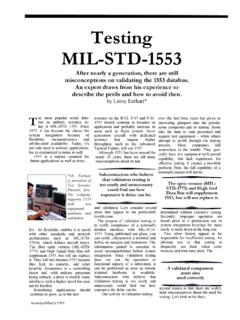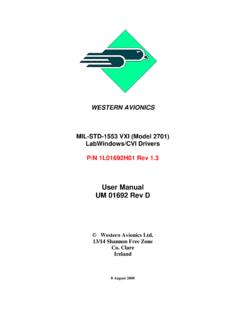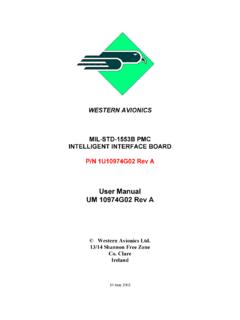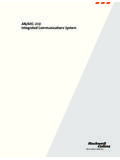Transcription of Frequently Asked Questions - TEST SYSTEMS
1 FAQS upporting MIL-STD-1553 since 1979 Page 1 of 4 TEST SYSTEMS , West Palmaire ! Phoenix, Arizona 85021 ! Phone (602) 861-1010E-mail: Web Page: Asked Questions about MIL-STD-1553 How old is MIL-STD-1553?The USAF developed and published MIL-STD-1553 in 1973. In 1975, revision A to thestandard was published as a tri-service standard. A task group in the SAE was formed in 1976to propose further changes resulting in the release of revision B to MIL-STD-1553 in September1978 as a tri-service/NATO standard.
2 USAF issued Notice 1 for the Standard in February SAE worked with DoD tri-service group to generate 1553B Notice 2 in September is Notice 2 and how important is it?Notice 2 is a tri-service notice to MIL-STD-1553 and supersedes Notice 1 which was an US AirForce notice. Notice 2 clarifies some issues in the standard and adds some new new requirements include setting the RT address from an external connector, requiredimplementation of four mode codes (Transmit Status, Transmitter Shutdown, Overridetransmitter shutdown, and Reset Remote Terminal), maximum time for Initiate Self-Test andReset Remote Terminal mode commands, Data Wrap-around, RT to RT receiver time-out, andmaximum allowable output noise during power-up or power-down.
3 Notice 2 is very important and any new design should comply with its is SEFAC testing? SYSTEMS Engineering Avionics Facility known as SEAFAC was a facility at Wright-PattersonAir Force Base that provided the technical support for MIL-STD-1553. Starting in the late 70'sthey starting providing a service of testing remote terminals to verify that they comply with therequirements of the Standard. In the early 90's they stopped testing remote terminals butcontinued testing components for MIL-STD-1553 and in 1993 they stopped providing thetesting service altogether.
4 There are two primary differences between the testing at SEAFACand the testing that we provide here at Test SYSTEMS : first, we do more complete testing than thetesting that was done at SEAFAC and second, we charge for our service (we try not to operateas a non-profit operation).What is the maximum length of the MIL-STD-1553 bus?Revision A of MIL-STD-1553 specifies a maximum length of 300 feet. Revision B does notspecify a maximum length. The length of the bus is part of the system design and is based onthe number of stubs, the length of the stubs, and spacing between Page 2 of 4 TEST SYSTEMS , is the impact of degraded input impedance to my system?
5 The MIL-STD-1553 data bus is a 70 - 85 Ohm terminated transmission line specified tominimize signal distortion with 'high' impedance terminals attached at various positions alongthe bus. If a terminal with 'low' impedance is present, excessive signal reflections may occurresulting in distortion. Distortion degrades the signals on the bus. As the signals becomedegraded, the system error rate increases resulting in reduced communication efficiency. Alldevices on the bus will suffer reduced margins. What would be the results of directly interconnecting two 1553 terminals without using a bus terminator?
6 First of all the standard specifies that the bus "..shall be " at both ends of the cablewith a resistor equal to the cable characteristic impedance. The purpose of this is to minimizethe effects of signal reflections causing waveform distortion. If no termination is used the distortion could be severe enough to prevent communication onthe bus, or the distortion could be insignificant allowing normal communication. A third andworse possibility would be that the signal may deteriorate just enough to cause intermittentcommunication. Don't bring upon yourself any more grief than necessary - terminate the bus!
7 What about stubs?A stub is an interconnection between the terminal and the data bus. Two methods for couplingto the bus are specified: transformer coupling and direct coupling. Transformer coupling, whichrequires a coupler near to the junction with the bus, is usually used when a longerinterconnecting stub is required (1 to 20 ft); direct coupling is used when the stub length is onefoot or less. Both coupling methods require fault isolation resistors in series with eachconnection to the bus. The length of a stub should be minimized and the use of long stubs isdiscouraged.
8 What if a system requires a stub longer than 20 feet?As stated above, long stubs are discouraged. Stub length should be minimized wheneverpossible. The Standard states "The length of a transformer coupled stub should not exceed 20feet" and " ..if installation requirements dictate, stub lengths exceeding those permissible". Thus, there is some latitude allowed in stub lengths. Longer stubscreate signal reflections which in turn result in signal distortion so caution is in unused stubs on the bus be terminated with 1000 Ohms? What should be done with unused stubs?
9 Studies show that unused stubs should not be terminated with a resistor but rather left opencircuited. A dust cover over an unused connector is not a bad idea Page 3 of 4 TEST SYSTEMS , type of stub is best?A transformer coupled stub is preferred in most cases. According to Notice 2 of the Standard,all terminals shall have transformer coupled stub connections. In US Air Force and US Armysystems only transformer coupled stub connections may be used. In US Navy SYSTEMS , eitherdirect coupled or transformer coupled stubs may be used but each terminal must have both typesof connections externally available.
10 From a technical standpoint, the direct coupled stub of less than approximately five feet inlength, presents less disturbance to the matched transmission line than the transformer coupledstub of the same length. Above five feet the transformer coupled stub causes less loading. Otherfactors favoring transformer coupled stubs are; increased DC isolation, increased common moderejection, and fault isolation for the entire stub and terminal. The Standard states that "Direct coupled stubs .. should be avoided if at all possible."What is the purpose of MIL-STD-1553 validation testing?







